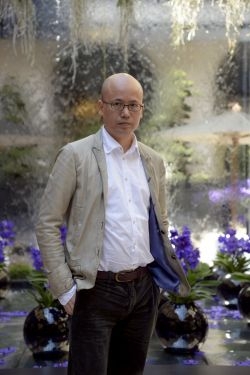In fashion, China gets its own first lady effect

Was this Exception’s “Jason Wu moment”? people asked, referring to the young Taiwanese-Canadian designer who shot to fame after Michelle Obama dazzled at the first inaugural ball in an ivory one-shoulder Wu creation.
Or would Peng’s championing of a domestic fashion label in the midst of a government “frugality” drive send a message to top officials’ wives to ditch the bling?
For many labels such publicity is the stuff of marketing dreams.
But in his first interview since Peng accompanied her husband President Xi Jinping to Russia in March, Exception founder Mao Jihong looks uncomfortable when the “first lady issue” is raised.
Peng, a star in China for over three decades, has been wearing Exception for 12 years and some clothes were specially designed for her, Mao told AFP in an interview in Paris.
And while the publicity surrounding her choice of an Exception double-breasted trench coat and leather handbag on her Russia trip was undoubtedly good for the brand, it has also been “lots of trouble”, he said.
“We just want to do fashion quietly. We never do campaigns or advertising but after the first lady wore our clothes (in Russia) lots of people came looking for us,” he said.
“We want to present the brand rather than use the first lady to make us famous. We never really wanted that,” he added.
The Exception story closely mirrors the short history of fashion design in modern-day China.
Graduating in 1991 from one of the country’s first fashion design courses, Mao and his ex-wife Ma Ke set about offering an alternative to the drab, shapeless clothes they saw around them.
“We were among the earliest design students in China. Back then clothing in China had no beauty and everybody was wearing the same thing like a uniform,” he said.
Today their label, one of the country’s very first to be established in the early 1990s, has a “tiny” presence in China of around 100 shops.
Their designs concentrate on natural fabrics such as linen, silk and wool in styles that create a sense of “freedom”.
“We wanted to define contemporary lifestyle in China with the brand and for people to discover the beauty and aesthetics of oriental philosophy through the designs,” Mao said.
The label’s first fashion show in 2004 was held in a derelict electric switch factory in Beijing.
The factory no longer exists having long since been demolished to make way for a vast shopping mall, a now familiar sign of rapid development in the nation of 1.3 billion.
Mao estimates that any one point around 40 shopping centres are under construction in each of the major cities such as Shanghai or Beijing.
He is careful, however, to distance Exception from such rampant consumerism, describing its clients as people who “love culture and art and have their own aesthetic point of view”.
But he predicts that even those with an entirely different mindset can soon be expected to adopt a more sophisticated approach to fashion buying.
“I think it is a process of development,” he said.
“In China there is no ‘noble’ class. There is no difference of social status and if people in China want to show that they are different they use a consumer item to identify who they are.
“I think that sooner or later the consumer will find themselves and they may not need those kinds of items to show off who they are,” he said.
Now plans are afoot to launch Exception in Europe after approaches from French department stores and buyers.
“We are working on those international plans… Everything is under discussion,” Mao said, adding however that the label was still very much a work in progress.
“We have never defined ourselves as a successful brand and I think we haven’t reached that yet. We are still on the way,” he said.

